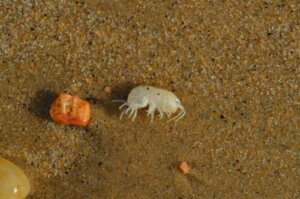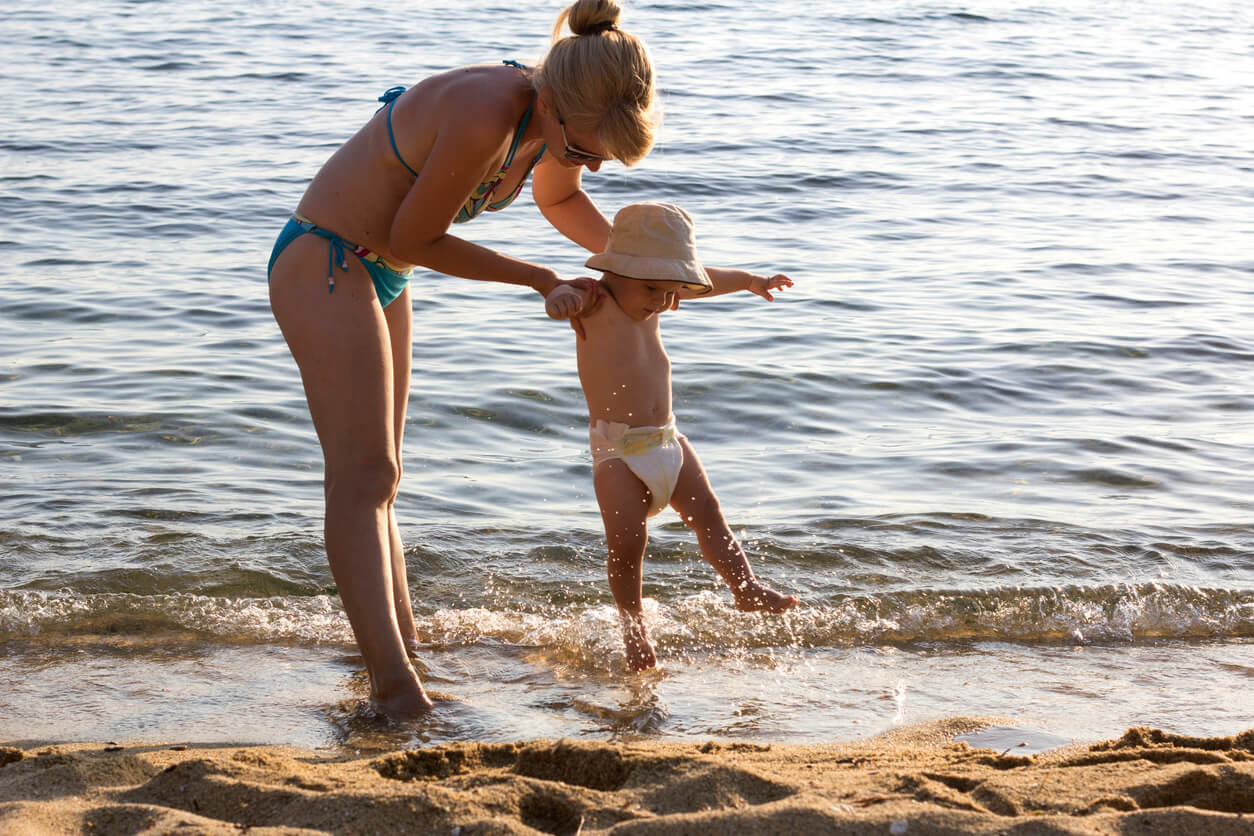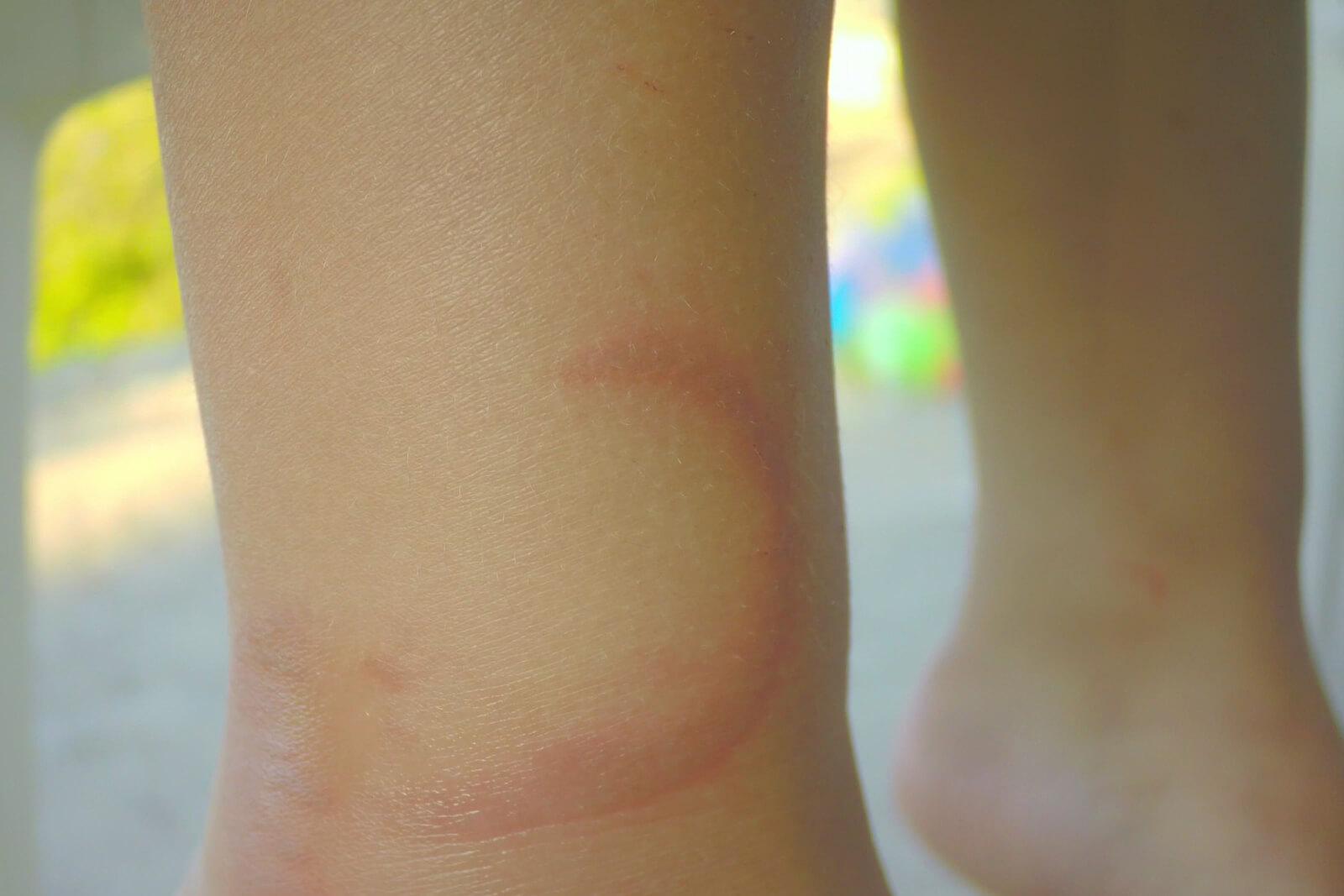What to Do if Your Child is Bitten by a Sea Louse?

The beach is one of the favorite vacation destinations for children. However, you should keep an eye on them when they’re in the water, as there are some marine species that could pose a threat to them. With that in mind, we’ll show you what to do if your child is stung by a sea louse.
Just like jellyfish or sea spiders, this organism has become a risk for bathers in warm water resorts. In addition, it can go unnoticed and sting children without them noticing.
The sting of the sea louse causes itching and discomfort and can turn your family trip to the beach into an odyssey. We invite you to learn more about this species and the recommended remedies to treat its bite, so keep reading!
Learn about the characteristics of the sea louse
The sea louse is a small isopod (or cochineal), which can measure up to four centimeters long. Its body is flattened, without lateral spines, and its head is attached to the first filament of the thorax. It has small rounded antennae, which aren’t very long, which it uses to orient itself. It also has teeth designed to bite its predators, or whoever disturbs its space, and to hunt. It grows in warm oceans or Caribbean waters and doesn’t tolerate the cold.
This type of louse is called a parasitic copepod and it usually survives on fish. The Caligidae family is the most common and consists of 31 genera and more than 450 species.
The small crustacean lives in brackish water and feeds on the skin, mucous membranes, and blood of aquatic animals. In particular, salmon and sea trout.

Signs and symptoms your child may exhibit if bitten by a sea louse
Those who are bitten by sea lice, whether they’re children, adolescents, or adults, will show rashes and redness on the skin, an intense burning sensation, itching, and even swelling in the areas of the bite.
Some people also develop other symptoms, such as nausea, vomiting, headache, fever, and diarrhea. If the bite’s severe, recovery time may be prolonged and last up to about two weeks.
When in the water, sea lice have a camouflage system that makes them almost invisible to the eye. They can crawl into swimsuits and bite without being noticed.
What to do if your child’s bitten by a sea louse?
If your child is attacked by sea lice, go to the doctor right away or call your child’s pediatrician to find out what medications to give your little one.
Topical corticosteroids and hydrogen peroxide are the two most effective treatments for sea lice bites. Your doctor will prescribe them for your child, but may also add antihistamines or antibiotics, depending on the severity of the lesions.
If you prefer, use a home remedy, such as applying white vinegar to the wounds. Acetic acid (vinegar) works as a powerful antiseptic that kills bacteria that infect the skin. It also cools and soothes the skin, making it ideal for sea lice bites. Your child will notice its refreshing action and feeling of calm and coolness. Apply it to the affected area with a sterilized gauze to avoid complications.

Prevention is key to enjoying a good vacation
Now that you know the sea lice and the dangers to which you and your family are exposed, you need to make sure that there have been no incidents with marine animals in the tourist destination.
Ask the local staff or lifeguards if there’s a chance of running into sea lice so you can prevent your children from being attacked. If you can’t avoid it, follow the recommendations we’ve offered you here to heal the bites.
The beach is one of the favorite vacation destinations for children. However, you should keep an eye on them when they’re in the water, as there are some marine species that could pose a threat to them. With that in mind, we’ll show you what to do if your child is stung by a sea louse.
Just like jellyfish or sea spiders, this organism has become a risk for bathers in warm water resorts. In addition, it can go unnoticed and sting children without them noticing.
The sting of the sea louse causes itching and discomfort and can turn your family trip to the beach into an odyssey. We invite you to learn more about this species and the recommended remedies to treat its bite, so keep reading!
Learn about the characteristics of the sea louse
The sea louse is a small isopod (or cochineal), which can measure up to four centimeters long. Its body is flattened, without lateral spines, and its head is attached to the first filament of the thorax. It has small rounded antennae, which aren’t very long, which it uses to orient itself. It also has teeth designed to bite its predators, or whoever disturbs its space, and to hunt. It grows in warm oceans or Caribbean waters and doesn’t tolerate the cold.
This type of louse is called a parasitic copepod and it usually survives on fish. The Caligidae family is the most common and consists of 31 genera and more than 450 species.
The small crustacean lives in brackish water and feeds on the skin, mucous membranes, and blood of aquatic animals. In particular, salmon and sea trout.

Signs and symptoms your child may exhibit if bitten by a sea louse
Those who are bitten by sea lice, whether they’re children, adolescents, or adults, will show rashes and redness on the skin, an intense burning sensation, itching, and even swelling in the areas of the bite.
Some people also develop other symptoms, such as nausea, vomiting, headache, fever, and diarrhea. If the bite’s severe, recovery time may be prolonged and last up to about two weeks.
When in the water, sea lice have a camouflage system that makes them almost invisible to the eye. They can crawl into swimsuits and bite without being noticed.
What to do if your child’s bitten by a sea louse?
If your child is attacked by sea lice, go to the doctor right away or call your child’s pediatrician to find out what medications to give your little one.
Topical corticosteroids and hydrogen peroxide are the two most effective treatments for sea lice bites. Your doctor will prescribe them for your child, but may also add antihistamines or antibiotics, depending on the severity of the lesions.
If you prefer, use a home remedy, such as applying white vinegar to the wounds. Acetic acid (vinegar) works as a powerful antiseptic that kills bacteria that infect the skin. It also cools and soothes the skin, making it ideal for sea lice bites. Your child will notice its refreshing action and feeling of calm and coolness. Apply it to the affected area with a sterilized gauze to avoid complications.

Prevention is key to enjoying a good vacation
Now that you know the sea lice and the dangers to which you and your family are exposed, you need to make sure that there have been no incidents with marine animals in the tourist destination.
Ask the local staff or lifeguards if there’s a chance of running into sea lice so you can prevent your children from being attacked. If you can’t avoid it, follow the recommendations we’ve offered you here to heal the bites.
All cited sources were thoroughly reviewed by our team to ensure their quality, reliability, currency, and validity. The bibliography of this article was considered reliable and of academic or scientific accuracy.
- Australian Red Cross. (s. f.). First Aid for someone with a jellyfish sting. Consultado el 6 de agosto de 2023. https://www.redcross.org.au/firstaid/basics/jellyfish/
- Biology online. (s. f.). Nematocisto. Consultado el 6 de agosto de 2023. https://www.biologyonline.com/dictionary/nematocyst
- Manual MSD. (2022). Picaduras de Cnidarios (celenterados, como medusas y anémonas de mar). https://www.msdmanuals.com/es-ve/professional/lesiones-y-envenenamientos/mordeduras-y-picaduras/picaduras-de-cnidarios-celenteradosr
- Neumors Kids Health (2022). Jellyfish Stings.
https://kidshealth.org/en/parents/jellyfish.html - Prohaska, J., Jamal, Z., & Tanner, L. (2022). Seabathers Eruption. Stat Pearls. https://www.ncbi.nlm.nih.gov/books/NBK482307/
- Rosseto, A., Dellatorre, G., Lang, F., Haddad, V. (2015). Seabather’s eruption: report of fourteen cases. Anales de la Academia Brasileña de Ciencias, 87 (01). https://www.scielo.br/j/aabc/a/76jt9QbNPZ3XYPnzjpwPqmn/?lang=en
- Vera, C., Kolbach, M., Zegpi, M., Vera, F., Lonza, J. (2004).
Picaduras de medusas: actualización. Revista medica de Chile. 32(2). https://www.scielo.cl/scielo.php?script=sci_arttext&pid=S0034-98872004000200014
This text is provided for informational purposes only and does not replace consultation with a professional. If in doubt, consult your specialist.








